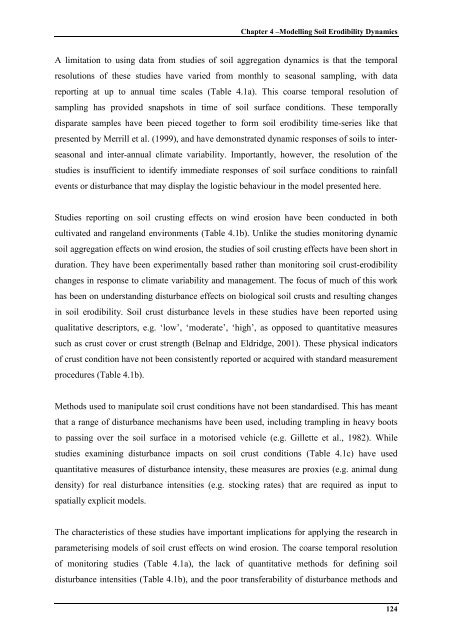Wind Erosion in Western Queensland Australia
Modelling Land Susceptibility to Wind Erosion in Western ... - Ninti One
Modelling Land Susceptibility to Wind Erosion in Western ... - Ninti One
You also want an ePaper? Increase the reach of your titles
YUMPU automatically turns print PDFs into web optimized ePapers that Google loves.
Chapter 4 –Modell<strong>in</strong>g Soil Erodibility DynamicsA limitation to us<strong>in</strong>g data from studies of soil aggregation dynamics is that the temporalresolutions of these studies have varied from monthly to seasonal sampl<strong>in</strong>g, with datareport<strong>in</strong>g at up to annual time scales (Table 4.1a). This coarse temporal resolution ofsampl<strong>in</strong>g has provided snapshots <strong>in</strong> time of soil surface conditions. These temporallydisparate samples have been pieced together to form soil erodibility time-series like thatpresented by Merrill et al. (1999), and have demonstrated dynamic responses of soils to <strong>in</strong>terseasonaland <strong>in</strong>ter-annual climate variability. Importantly, however, the resolution of thestudies is <strong>in</strong>sufficient to identify immediate responses of soil surface conditions to ra<strong>in</strong>fallevents or disturbance that may display the logistic behaviour <strong>in</strong> the model presented here.Studies report<strong>in</strong>g on soil crust<strong>in</strong>g effects on w<strong>in</strong>d erosion have been conducted <strong>in</strong> bothcultivated and rangeland environments (Table 4.1b). Unlike the studies monitor<strong>in</strong>g dynamicsoil aggregation effects on w<strong>in</strong>d erosion, the studies of soil crust<strong>in</strong>g effects have been short <strong>in</strong>duration. They have been experimentally based rather than monitor<strong>in</strong>g soil crust-erodibilitychanges <strong>in</strong> response to climate variability and management. The focus of much of this workhas been on understand<strong>in</strong>g disturbance effects on biological soil crusts and result<strong>in</strong>g changes<strong>in</strong> soil erodibility. Soil crust disturbance levels <strong>in</strong> these studies have been reported us<strong>in</strong>gqualitative descriptors, e.g. ‘low’, ‘moderate’, ‘high’, as opposed to quantitative measuressuch as crust cover or crust strength (Belnap and Eldridge, 2001). These physical <strong>in</strong>dicatorsof crust condition have not been consistently reported or acquired with standard measurementprocedures (Table 4.1b).Methods used to manipulate soil crust conditions have not been standardised. This has meantthat a range of disturbance mechanisms have been used, <strong>in</strong>clud<strong>in</strong>g trampl<strong>in</strong>g <strong>in</strong> heavy bootsto pass<strong>in</strong>g over the soil surface <strong>in</strong> a motorised vehicle (e.g. Gillette et al., 1982). Whilestudies exam<strong>in</strong><strong>in</strong>g disturbance impacts on soil crust conditions (Table 4.1c) have usedquantitative measures of disturbance <strong>in</strong>tensity, these measures are proxies (e.g. animal dungdensity) for real disturbance <strong>in</strong>tensities (e.g. stock<strong>in</strong>g rates) that are required as <strong>in</strong>put tospatially explicit models.The characteristics of these studies have important implications for apply<strong>in</strong>g the research <strong>in</strong>parameteris<strong>in</strong>g models of soil crust effects on w<strong>in</strong>d erosion. The coarse temporal resolutionof monitor<strong>in</strong>g studies (Table 4.1a), the lack of quantitative methods for def<strong>in</strong><strong>in</strong>g soildisturbance <strong>in</strong>tensities (Table 4.1b), and the poor transferability of disturbance methods and124
















